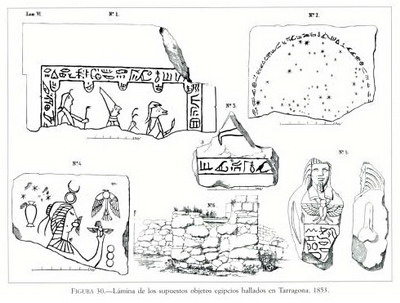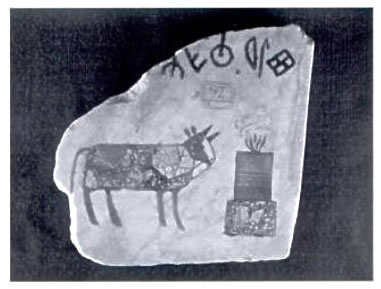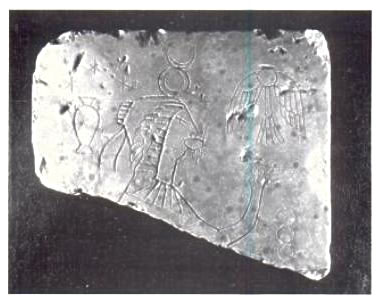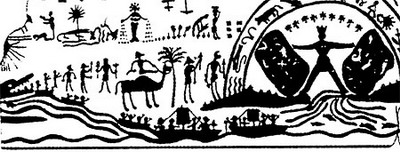|
Note the article below reports the finding of Ancient Egyptian remains in
southwest Spain in the general area of Classical Tarshish. |
|
Details on How To Contribute to Brit-Am |
|
Brit-Am Discussion Group |
Contents by Subject |
Research Recognition Reconciliation Contribute |
|
Site Map Contents in Alphabetical Order |
This Site |
|
The fragments of the tomb are now at the Royal Academy of History in Madrid, and were exhibited at the Museum of the city of Tarragona to mark the centenary of the death of the archaeologist B. Hernandez Sanahuja en 1991. In the Museum of Tarragona are exhibited three Egyptian scarabs and the piece of a brass sphinx. There is no clear chronology. The whereabouts mummy as to where the mummy was found are unknown. The official view is that this is a scam, but there is data in books from he last century about it. The story of the discovery of these unique remains is the following, as Hernandez Sanahuja explains himself in his work (1855): Summary historical-critical of the city of Tarragona, from its establishment to the Roman period, with an explanation of fragments of Egyptian tomb discovered in March 1850: In March 1850, prison-workers assigned to the the port quarry , found at the site of the Protestant cemetery a pavement of large slabs belonging to the Roman period . Deeper down they found what was, by all indications, another layer of Greek-Iberian origin. Between the Greek-Iberian layer and the bed rock, they found the controversial [Egyptian] shrine, covered with red inlay ... Unfortunately, the workers destroyed the monument, believing that it was of no interest. Sanahuja, in the work cited, gives a lengthy description of 40 of the fragments that were saved from the quarry and other related finds discovered two years later. Carles Babot Boixeda, the Deputy Mayor of Tarragona Heritage in early last century transcribed the manuscript of Buenaventura Hernandez Sanahuja ("Fifteen years postscript" ). Concerning the controversial remains of the Egyptian tomb and its affiliates there was expressed new currents of archaeological and anthropological studies of the time. These opinions "retreated" from their earlier statements first and revised the previous opinions. The Berlin Academy, among others, had carefully studied the remains and described them as "Apocrypha", i.e. a more or less successful Recreation probably made in the early Christian era by artists who wanted to emulate an Egyptian-style tomb. He explains that the main reason the Berlin Academy rejected the idea of the presence of any Egyptian colony in Spain was the lack of Egyptian records regarding such a colony. The manuscript goes on to explain that effectively, says Mr. Ross....these monuments are of fictitious or doubtful provenance. They belong to an indeterminate period, depict abnormal or whimsical representations lending themselves to various interpretations, such as are not rare in Europe...we know of other findings similar to those of Tarragona, discovered in Sardinia in the fifteenth century, about which the distinguished Italian archaeologist, General Alberto of Marmara wrote a scholarly essay in 1853 ...After making a brief description of the different opinions of various researchers on the fragments Sanahuja tells us that: "... All these considerations prompted us to remove the background booklet about the grave and not mention it as historical fact . He gives no account here, however, concerning the constant pressure he had to suffer from certain sectors that led him at one stage to get rid of some of the findings...the possibility was raised on many occasions, along with threats and insinuations, that he lose his official position because of the much discussed archaeological discovery, - I refer here to the fact that many archaeologists and researchers have had to suffer and endure similar treatment in our time... This brings to mind Galileo Galilei before the Inquisition having to retract his heliocentric statements, though adding "Eppur si muove", meaning "and yet it moves" alluding to the Earth. ...Sanahuja made clear that, given the emerging new theory of official historical and the strength of those who branded the Egyptian finds from the quarry and the port of Tarragona as "false" and given the discredit and the loss that threatened him, he decided it is better to be prudent and change his mind. THE BEREA "by Alexandre Eleazar.... setting out in writing Iberian texts translated into a language very similar to current Euskera [Basque]. ...something more than five thousand Egyptian troops arrived in the Iberian Peninsula to conduct a military campaign and occupy those territories. The pharaoh TEO II ....founded the city of Tarteose and appointed an Egyptian prince over Iberia. Eleazar said that the much sought Tartessos Kingdom of the Principality was actually Egyptian that swept to one side and the other from the mouth of the Ebro River present city of Tortosa was founded as an Egyptian Pharaoh and his troops. |
Note: | |
 |
 |
 |
 |
 |
 |

